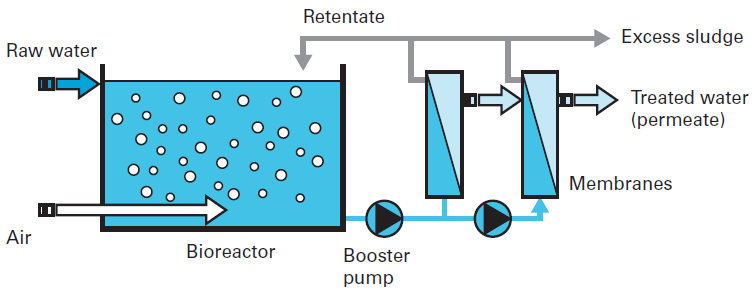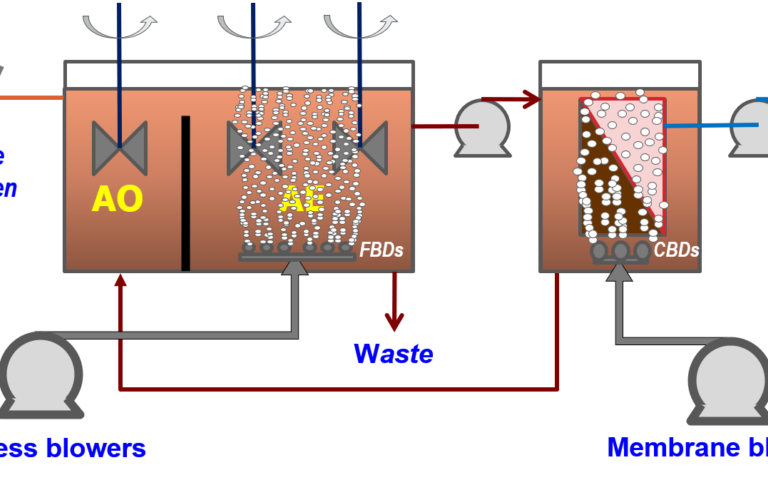Why Membrane Bioreactor is the Future of Wastewater Treatment in Industries
Why Membrane Bioreactor is the Future of Wastewater Treatment in Industries
Blog Article
Recognizing Membrane Bioreactors: The Future of Wastewater Therapy
Membrane bioreactors (MBRs) represent a significant innovation in the field of wastewater therapy, incorporating biological processes with innovative membrane layer purification to enhance effluent high quality. As global water scarcity and rigid regulatory frameworks end up being significantly pushing issues, MBR technology provides an efficient reaction via its ability to decrease footprint and maximize resource healing.
What Are Membrane Layer Bioreactors?

The core parts of MBR systems include a bioreactor where microbial activity occurs and a membrane device that filters the mixed liquor. This double capability makes it possible for the synchronised degradation of organic issue and solid-liquid separation in a solitary step. MBRs can operate in both submerged and external setups, with immersed systems being much more common due to their portable layout and functional performance.
The adoption of MBR innovation has actually gotten grip in different applications, ranging from metropolitan wastewater therapy to commercial effluent management. MBRs are especially helpful in scenarios where space is rigorous or minimal effluent quality standards must be fulfilled. By maintaining a high concentration of microorganisms within the bioreactor, MBRs enhance the degradation of organic pollutants, thus generating greater treatment efficiencies contrasted to typical methods.
Trick Benefits of MBR Modern Technology
The combination of organic treatment with membrane layer filtering in MBR systems supplies numerous advantages that set it apart from typical wastewater therapy approaches. One of the key advantages is the improved effluent quality. MBRs efficiently get rid of put on hold solids and pathogens, achieving greater levels of filtration that meet strict discharge standards and help with water reuse applications.

One more significant advantage is the minimized sludge manufacturing. MBR systems produce much less excess sludge, causing reduced disposal prices and a decline in ecological influence. The shut nature of the membrane layer system reduces the risk of odor discharges and improves overall procedure control.
Last But Not Least, MBRs are adaptable and versatile, making them appropriate for different wastewater kinds, consisting of industrial and metropolitan sources. The capacity to integrate with advanced therapy innovations even more enhances their effectiveness, making MBRs an appealing service for the future of wastewater monitoring.
Difficulties and Limitations of MBRs
While MBR technology provides countless benefits, it additionally faces numerous obstacles and limitations that can affect its widespread adoption. One significant difficulty is the high capital and functional expenses associated with MBR systems. The first investment for membrane layer products and the needed facilities can be considerable, making it less accessible for smaller sized industries or communities.
In addition, membrane fouling continues to be a critical problem that can lessen system efficiency and boost upkeep needs. Fouling happens when solids, raw material, or microbes accumulate on the membrane layer surface, leading to reduced permeability and calling for constant cleaning or substitute.
An additional limitation entails the intricacy of the technology. MBR systems call for knowledgeable workers for procedure and maintenance, which can be a barrier in regions with restricted technological knowledge. The disposal of invested membranes offers environmental issues, as the materials are often not biodegradable and can contribute to squander monitoring obstacles.
Lastly, while MBRs can efficiently treat a large range of wastewater, they may not appropriate for all applications, particularly those with high focus of fats, oils, and oils, requiring additional study and advancement to address these restrictions.
Applications of Membrane Bioreactors
In various fields, membrane layer bioreactors (MBRs) have actually become a functional option for wastewater treatment (Membrane Bioreactor). Their applications span local, commercial, and agricultural Visit Your URL setups, showcasing their adaptability and performance in diverse settings. In community wastewater therapy plants, MBRs dramatically enhance effluent high quality, enabling water reuse and minimizing the environmental influence of discharged wastewater
Industrially, MBRs are utilized in food and beverage handling, textile manufacturing, and pharmaceutical manufacturing, where they effectively deal with high-strength waste streams. Their capacity to manage varying tons and differing impurity focus makes them especially useful in these industries. In addition, MBRs help with the removal of virus, put on hold solids, and raw material, contributing to compliance with rigorous discharge regulations.
In agriculture, MBRs are increasingly made use of for treating agricultural overflow and livestock wastewater, making it possible for the recovery of nutrients for plant food production. They additionally help in the treatment of greywater for irrigation, promoting lasting water monitoring Home Page techniques.
The convenience of MBRs is more confirmed by their combination with other innovations, such as anaerobic food digestion and progressed oxidation processes, enhancing overall performance and source recuperation in wastewater therapy systems.
The Future of Wastewater Therapy
Innovations in modern technology and an expanding emphasis on sustainability are forming the future of wastewater treatment. Membrane bioreactors (MBRs) exemplify this shift by integrating biological treatment processes with membrane layer purification, causing premium effluent suitable for reuse. The fad towards round economies is triggering facilities to take on MBRs for their capability to recuperate resources, such as water and nutrients, from wastewater.
Innovations in membrane layer materials and setup are boosting the efficiency and long life of MBR systems, decreasing functional prices and power intake. Smart technology combination, including real-time monitoring and automated control systems, is additional maximizing efficiency and making it possible for predictive maintenance, hence lessening downtime.
Additionally, governing stress and societal assumptions are pressing towns and industries to take on more sustainable techniques. Membrane Bioreactor. The change towards decentralized wastewater treatment remedies is acquiring traction, enabling local therapy that minimizes transport expenses and power use
Final Thought
Membrane layer bioreactors (MBRs) stand for a transformative strategy to wastewater therapy, integrating biological processes with innovative membrane modern technology. The benefits of MBRs, including improved effluent high quality, decreased spatial demands, and reduced sludge production, place them as a viable option amidst growing urbanization and stricter ecological regulations. Regardless of existing difficulties, the ongoing innovation in membrane layer materials and operational techniques guarantees to reinforce the efficiency and fostering of MBRs, guaranteeing their essential function in the future of sustainable wastewater administration.
Membrane layer bioreactors (MBRs) stand for a significant innovation in the area of wastewater treatment, integrating biological processes with innovative explanation membrane filtering to boost effluent top quality.Membrane layer bioreactors (MBRs) incorporate biological therapy processes with membrane layer filtration to successfully treat wastewater.The combination of organic treatment with membrane filtering in MBR systems uses various advantages that establish it apart from standard wastewater therapy approaches. Membrane bioreactors (MBRs) exhibit this shift by integrating organic treatment procedures with membrane filtering, resulting in premium effluent ideal for reuse.Membrane bioreactors (MBRs) represent a transformative strategy to wastewater therapy, incorporating organic processes with advanced membrane layer modern technology.
Report this page